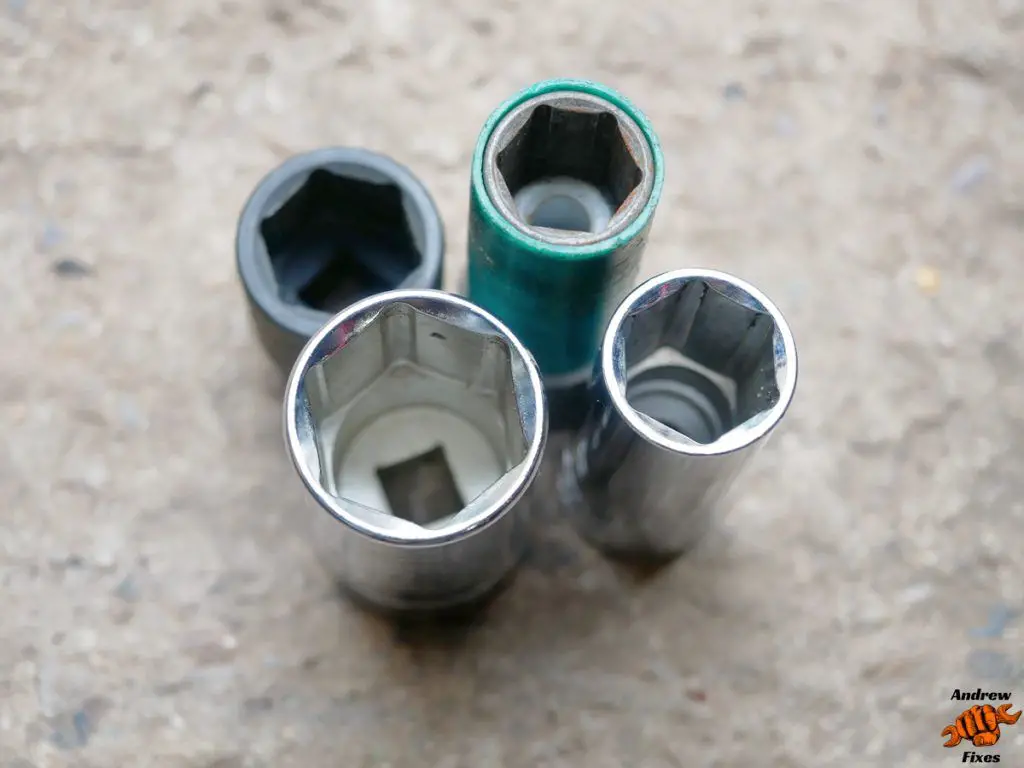Choosing between a 6 point socket and a 12 point socket is an important decision when selecting tools for automotive repair or maintenance. There are pros and cons to each type of socket, and the right choice depends on the specific needs and preferences of the user.
Page Contents
What is a 6 Point Socket?
A 6 point socket, also known as a hex socket, has 6 internal splines or lobes that grip onto the 6 sides of a hex fastener head. The hex shaped inner drive allows for transfer of high amounts of torque from the tool to the fastener.
Advantages of 6 Point Sockets
- Better grip and torque transfer – The 6 splines grip the hex fastener at all 6 contact points, allowing for maximum torque to be applied without slippage or rounding of fastener corners.
- Durability – The thick walls and minimal moving parts of a 6 point socket make it extremely durable and rugged.
- Works with worn fasteners – The 6-sided grip can still work with worn or damaged external hex fastener heads, whereas 12 points may lose grip.
- Prevents corner rounding – The 6-point contact distributes torque evenly and minimizes the chances of rounding off the corners of the fastener hex shape.
Disadvantages of 6 Point Sockets
- Limited grip angles – The 6 points only allow the fastener to be gripped from one angle. Faster adjustment between different angles may be required.
- Not suited for soft/delicate fasteners – The strong 6-point grip can damage softer brass, aluminum or plastic fastener heads.
- Higher replacement cost – Since they are made with thicker, high strength steel, replacement cost per socket is higher than 12 point.
What is a 12 Point Socket?
A 12 point socket has 12 internal splines or lobes that make contact with the corners and flats of a hex fastener. The increased contact points allow for gripping from multiple angles.
Advantages of 12 Point Sockets
- Flexibility in tight spaces – The 12 gripping points allow a fastener to be gripped from multiple angles using the same socket. This allows for easier use in tight or hard to reach spaces.
- Reduced fastener damage – By distributing torque over 12 points rather than 6, a 12 point socket is less likely to round off or damage fastener corners.
- Faster work – The multiple grip angles mean less time adjusting between sockets or looking for the right angle.
- Lower replacement cost – With thinner walls and minimal material, 12 point sockets cost comparatively less to replace.
Disadvantages of 12 Point Sockets
- Weaker grip strength – With only 2 flat sides making contact, the grip strength of a 12 point socket is lower compared to a 6 point.
- Higher wear and tear – The thinner construction means 12 point sockets are more prone to wear, stripping and deformation under high torque.
- Higher risk of slippage – Under high torque, the lower grip strength means an increased risk of rounding or slippage.
- Not for worn fasteners – Rounded off or damaged exterior fastener heads are less likely to grip properly in a 12 point socket.
6 Point vs 12 Point Socket Comparison
Here is a comparison of some key factors when choosing between 6 point and 12 point sockets:
| Factor | 6 Point Socket | 12 Point Socket |
|---|---|---|
| Grip Strength | High | Moderate |
| Torque Transference | Excellent | Moderate |
| Durability | High | Moderate |
| Flexibility in Tight Spaces | Low | High |
| Fastener Damage Risk | Moderate | Low |
| Replacement Cost | High | Low |
When to choose a 6 point socket:
- Heavy duty applications requiring maximum torque transfer
- Lug nuts, axle nuts, or other critical automotive fasteners
- Rusted, worn or damaged external fastener heads
- Reducing risk of fastener head rounding or slippage
- Durability and ruggedness are top priority
When to choose a 12 point socket:
- Light duty automotive or mechanical applications
- Frequent socket changes in cramped spaces
- Delicate fasteners where damage is a concern
- Speed and flexibility are top priority
- Cost sensitivity or budget constraints
Best Practices When Using Sockets
To get the most out of your socket set and avoid damage, keep these tips in mind:
- Use the correct size socket – Do not use undersized sockets or hammer on sockets to force onto fastener heads.
- Use proper extensions for increased torque – Short/minimal extensions reduce risk of breakage.
- Use a torque wrench when appropriate – Tighten critical fasteners to vehicle specs.
- Store sockets properly – Keep them organized and free of debris/moisture.
- Replace damaged sockets – Cracked, chipped or warped sockets should be immediately replaced.
- Choose impact rated – Impact sockets are thicker/stronger for power tool use.
- Lubricate the fastener – A little penetrating oil will help avoid binding or slippage.
Conclusion
While 12 point sockets offer more flexibility for speed and ease of use, 6 point sockets grip and transfer torque better for demanding mechanical applications. For most mechanics, a socket set combining both 6 point and 12 point sockets will provide the right tool for any fastening job. Select 6 point sockets for high torque needs like axles, lug nuts and large bolts. Use 12 point for general automotive work where speed and accessibility matter. With responsible use and care, quality 6 point and 12 point socket sets will provide reliable service for years to come.
